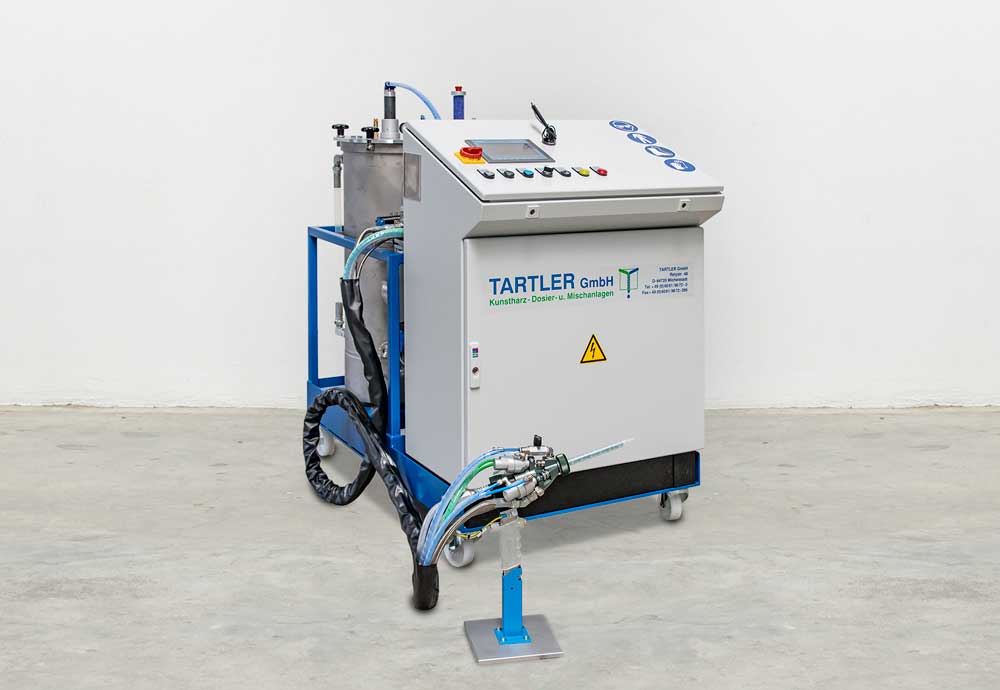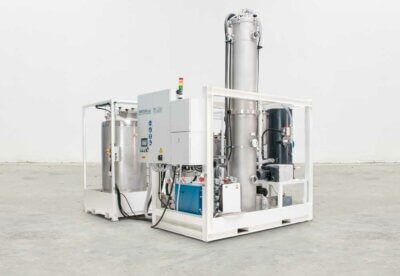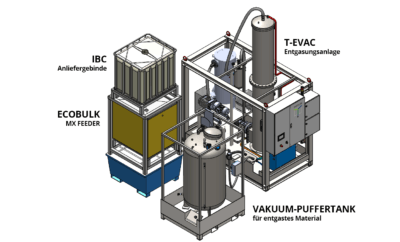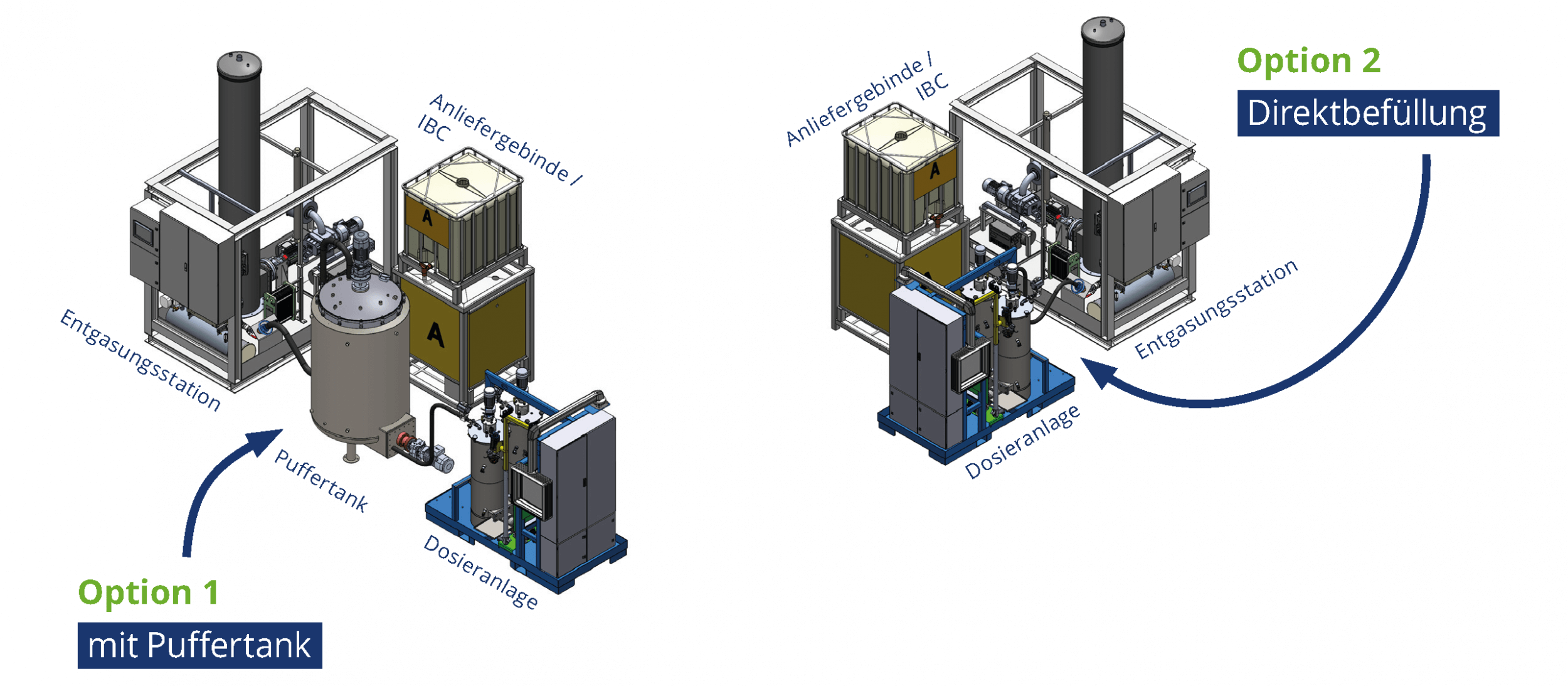
Compact bridge to large-scale solutions
27. September 2022
TARTLER expands MDM series with a new top-of-the-range model for resin processing The compact 2-component resin processing systems of the [...]
Tags: MDM, Produktportfolio


12. September 2019
 Whether it’s vacuum infusion, RTM, wet moulding or pultrusion – many plastics processors face the same dilemma when it comes to dosing and mixing resins and hardeners: air and moisture in the supplied material have a detrimental effect on the quality of the mixture, on the moulding process and ultimately on the end product. Increasingly, they wish to be able to free the components of these two disturbance factors before they find their way into the dosing and mixing system. Plant manufacturer TARTLER has developed the new system solution T-EVAC for process-integrated vacuum degassing for this purpose. We will present for the first time at Composites Europe in Stuttgart in Hall 9.
Whether it’s vacuum infusion, RTM, wet moulding or pultrusion – many plastics processors face the same dilemma when it comes to dosing and mixing resins and hardeners: air and moisture in the supplied material have a detrimental effect on the quality of the mixture, on the moulding process and ultimately on the end product. Increasingly, they wish to be able to free the components of these two disturbance factors before they find their way into the dosing and mixing system. Plant manufacturer TARTLER has developed the new system solution T-EVAC for process-integrated vacuum degassing for this purpose. We will present for the first time at Composites Europe in Stuttgart in Hall 9.
After its most recent innovations for the air-free changing of clamping ring lidded drums and the high-precision small-quantity application of low-viscosity synthetic resins, TARTLER will now be presenting its next innovation at Composites Europe (10.-12.9.2019): the vacuum degassing unit T-EVAC for the process-integrated evacuation of air and moisture from synthetic resins and hardeners before dosing and mixing. The German plant manufacturer thus offers all users who use the methods of vacuum infusion, wet moulding, resin transfer moulding (RTM) and pultrusion another means of decisively improving both their moulding processes and their product quality. The new degassing unit from TARTLER is suitable for epoxy resin and polyurethane resin degassing. The system solution design comes in two versions: in the form of offline degassing at a central point, from where you can fill the tanks of multiple dosing systems with degassed material. The second version comes as inline degassing, directly integrated into the dosing system and tailored to the process requirements.
 The entry of air and moisture from the supplied resin and hardener components ranks high among the daily annoyances for users of the previously mentioned plastics processing methods. That is because these flaws have a negative impact on the quality of the components. It is particularly a common issue during the production of components from composite materials. In resin transfer moulding and infusion technology, the evacuated moulding tools would have to take out the air and moisture from the material at the same time as the material is filling the mould. A good result is not possible due to the air and moisture being trapped inside the reinforcements with no route to be evacuated. TARTLER’s new system solution therefore intervenes at a much earlier process stage: before the material from the supplied drum (e.g. IBC) even gets into the dosing and mixing system (or a subsequent drum), it is “evacuated” of air and moisture in the T-EVAC. At the same time, it is conditioned to the desired processing temperature to achieve the best possible performance for processing. The entire process chain is hermetically sealed and is constantly under vacuum (< 5 mbar). And so, what you see arrive at a constant, unchanging flow speed in the dosing and mixing system, is optimally prepared material – free of contaminated air and moisture.
The entry of air and moisture from the supplied resin and hardener components ranks high among the daily annoyances for users of the previously mentioned plastics processing methods. That is because these flaws have a negative impact on the quality of the components. It is particularly a common issue during the production of components from composite materials. In resin transfer moulding and infusion technology, the evacuated moulding tools would have to take out the air and moisture from the material at the same time as the material is filling the mould. A good result is not possible due to the air and moisture being trapped inside the reinforcements with no route to be evacuated. TARTLER’s new system solution therefore intervenes at a much earlier process stage: before the material from the supplied drum (e.g. IBC) even gets into the dosing and mixing system (or a subsequent drum), it is “evacuated” of air and moisture in the T-EVAC. At the same time, it is conditioned to the desired processing temperature to achieve the best possible performance for processing. The entire process chain is hermetically sealed and is constantly under vacuum (< 5 mbar). And so, what you see arrive at a constant, unchanging flow speed in the dosing and mixing system, is optimally prepared material – free of contaminated air and moisture.
TARTLER will be providing insight into its degassing station in front of a large audience for the first time at the upcoming Composites Europe in Hall 9 at Booth D74. Here, trade fair visitors will discover many more details about the new system. For example, that it is offered in various expansion steps and module variants for different resins and hardeners. Or that it operates with a Siemens PLC control system, which is controlled via a colour touchscreen that also permits the integration of individual users’ wishes. Other important features of the T-EVAC: the degassing capacity starts at 1000 litres per hour and the built-in components are monitored by integrated sensors, which form an integrated protection system. In order to ensure the trouble-free connection of IBCs, the new degassing station is equipped with a 1200 litre ECOBULK MX feeder system coupling with a Kamlok adapter.
In principle, the new T-EVAC from TARTLER is directly connected to the dosing and mixing machine or alternatively an additional buffer tank can be connected upstream. The tank is then positioned between the degassing station and the dosing and mixing machines in the process chain. The tank provides the necessary storage conditions of the degassed material under full vacuum to prevent air and moisture quickly re-entering the treated material. The buffer tank can also provide the optimal material temperature. The dosing machine can then quickly filled from this buffer tank.
With TARTLER’s new vacuum degassing station, suppliers of automotive components, manufacturers of fans, producers of composite components and many other plastics processors are provided with the possibility to significantly improve their process chain in a hitherto troublesome area. They can thus increase system availability, improve processing efficiency by reducing repairs, and finally increase the quality of their product. More information on the T-EVAC system can be found at www.tartler.com.





